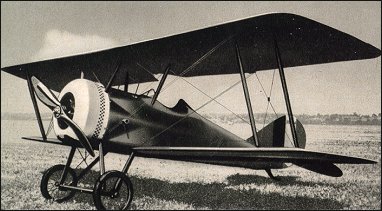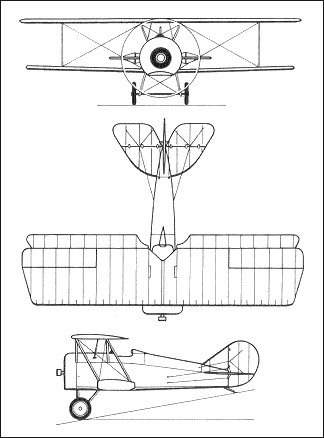|
| The S-4 was a single-seat advanced trainer of which about 600 were built, most going to the USAAS but a few also to the US Navy from 1917. The S-4B initial production version and a number of S-4C were powered by 74.5kW Gnome rotary engines, but the vast majority of aircraft produced were 59.6kW Le Rhone-powered S-4C. The designation S-5 was applied to a handful of S-4B fitted with float landing gears and operated by the US Navy.
| MODEL | S-4C |
| CREW | 1 |
| ENGINE | 1 x 80hp Le Rhone 9C |
| WEIGHTS |
| Take-off weight | 623 kg | 1373 lb |
| Empty weight | 438 kg | 966 lb |
| DIMENSIONS |
| Wingspan | 8.08 m | 27 ft 6 in |
| Length | 6.05 m | 20 ft 10 in |
| Height | 2.46 m | 8 ft 1 in |
| Wing area | 21.7 m2 | 233.58 sq ft |
| PERFORMANCE |
| Max. speed | 153 km/h | 95 mph |
| Ceiling | 4500 m | 14750 ft |
| ARMAMENT | 1 x 7.62mm machine-gun |
| Klaatu83, e-mail, 09.01.2013 01:38 If ever an aircraft owed it's fame to the movies, this one was it! The handsome little "Tommy-Scout" was never used in combat during World War I, having been employed solely as a trainer in the United States. However, lots of these airplanes became available after the war on the surplus market, and many ended up being used in Hollywood movies of the period, such as The Dawn Patrol, to represent World War I combat types.
Incidentally, this was an original design, it was not a copy of either Nieuport or Sopwith designs. It was reputedly a very good aircraft to fly but, having only an 80-hp engine, was considered inadequate for the combat conditions prevailing during 1917 and 1918. reply | | Christopher Closs, e-mail, 02.03.2012 20:28 I have photo of my father, (Willard E. Closs 1899-1977, then of Elizabeth, NJ) taxiing his S-4 (B or C) onto the runway at Teterboro in 1921. I recall him telling me many years ago that at that time he had to taxi across railroad tracks (with a tail skid no less!) to line up for take-off (the tracks are visible in the photo!) He had bought the aircraft as government surplus - still in the wooden crate - for $500, assembled it hiself and flew it for a couple of years, including flying into Lakehurst for an airshow around 1924 and the old US Airmail field at Piscataway, where Englehard Industries is now along I-287. He later sold the creft to someone at Roosevelt Field, LI, NY. He remarked to me years later that he often wondered if this ship was the one acquired by Cole Palin for use at the Rhinebeck Aerodrome. In the late '80's I visited Ithaca, NY where the TM Scouts were built, and with a little research of Sanborn Insurance Maps, found the brick factory where these were built (was Emerson Electric in 1989) and the site of the lumber yard and rail siding where the spruce was shipped in from Washington State and stickered for seasoning. reply | | Alan Cagan, e-mail, 18.03.2011 14:53 The "" was the best fighter training airplane produced in the US during World War I. It was called the Tommy. 497 were produced by the Air Service. It had an 80 hp LeRhone rotary engine. It is an American copy of the Sopwith Pup. reply | | Jim Landon, e-mail, 19.06.2008 03:11 This organization owns two S4C's:
www.vintageaviation.org / reply | |
| | MaryAnn Stanek, e-mail, 17.11.2006 12:08 I am a librarian, & we have a question concerning this aircraft. Where was the fuel tank located?? Average fuel burned per hour??(realize that wind, etc., are factors). Thanks for any help you can give us. reply |
|
Do you have any comments?
|
| 
COMPANY
PROFILE
All the World's Rotorcraft
|







